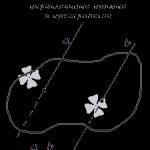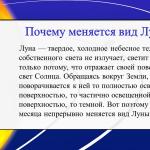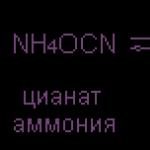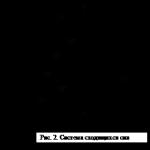The two systems of forces balance each other. Is it possible to say that their resultants are equal in magnitude and directed in the same straight line? Forces balance each other Two forces balance each other
- The elastic force arises due to deformation of the body, that is, a change in its shape. The elastic force is due to the interaction of the particles that make up the body.
- The force acting on the body from the support is called the normal reaction force.
- Two forces balance each other if these forces are equal in magnitude and directed in opposite directions. For example, the force of gravity and the force of normal reaction acting on a book lying on the table balance each other.
- The force with which a body presses on a support or stretches a suspension due to the attraction of the body by the Earth is called the weight of the body.
- The weight of a body at rest is equal to the force of gravity acting on this body: for a body at rest with mass m, the weight module P = mg.
- The weight of the body is applied to the support or suspension, and the force of gravity is applied to the body itself.
- The state in which the body weight is zero is called the state of weightlessness. In a state of weightlessness there are bodies on which only the force of gravity acts.
Questions and tasks
- What is elastic force? Give some examples of such power. What causes this force to arise?
- What is normal reaction force? Give an example of such power.
- When do two forces balance each other?
- What is body weight? What is the weight of a body at rest?
- What is approximately your weight?
- What common mistake does a person make when they say they weigh 60 kilograms? How to fix this error?
- Andrey's mass is 50 kg, and Boris's weight is 550 N. Which of them has more mass?
Second level
- Give your own examples of cases when the deformation of the body, causing the appearance of elastic force, is noticeable to the eye and when it is invisible.
- What is the difference between weight and gravity and what do they have in common?
- Draw the forces acting on the block lying on the table. Do these forces balance each other?
- Draw the forces with which a block lying on a table acts on the table, and the table acts on the block. Why can’t we assume that these forces balance each other?
- Is the weight of a body always equal to the force of gravity acting on this body? Justify your answer with an example.
- What mass body could you lift on the Moon?
- What is the state of weightlessness? Under what condition is a body in a state of weightlessness?
- Is it possible to be in a state of weightlessness near the surface of the Moon?
- Compose a problem on the topic “Weight” so that the answer to the problem is: “On the Moon I could, but on Earth I couldn’t.”
First level
Home laboratory
- What forces and from what bodies act on you when you stand? Do you feel these forces at work?
- Try being in a state of weightlessness.
a) Yes, you can.
b) No, you can’t.
IN WHICH OF THE CASES INDICATED IN FIGURE 1, THE TRANSFER OF FORCE FROM POINT A TO POINTS B, C OR D WILL NOT CHANGE THE MECHANICAL STATE OF THE SOLID BODY?
IN FIG. 1, b SHOW TWO FORCES, THE LINES OF ACTION OF WHICH LIE IN THE SAME PLANE. IS IT POSSIBLE TO FIND THEIR EQUAL ACTION BY THE PARALLELOGRAM RULE?
b) It is impossible.
5. Find a correspondence between the formula for determining the resultant of two forces F 1 and F 2 and the value of the angle between the lines of action of these forces
CONNECTIONS AND THEIR REACTIONS
IN WHICH RELATIONS LISTED BELOW ARE THE REACTIONS ALWAYS DIRECTED NORMAL (PERPENDICULAR) TO THE SURFACE?
a) Smooth plane.
b) Flexible connection.
c) Rigid rod.
d) Rough surface.
WHAT IS THE SUPPORT REACTION APPLIED TO?
a) To the support itself.
b) To the supporting body.
STANDARD ANSWERS
| Issue No. | |||||||
| No. |
FLAT SYSTEM OF CONVERGING FORCES
Choose the correct answer
8. AT WHAT VALUE OF THE ANGLE BETWEEN THE FORCE AND THE AXIS IS THE FORCE PROJECTION EQUAL TO ZERO?
IN WHICH OF THE CASES IS THE FLAT SYSTEM OF CONVERGING FORCES BALANCED?
A) å Fix = 40 H; å F iy = 40 H.
b) å Fix = 30 H; å F iy = 0 .
V) å Fix = 0 ; å F iy = 100 H.
G) å Fix = 0; å F iy = 0 .
 10. WHICH OF THE SYSTEMS OF EQUILIBRIUM EQUATIONS LISTED BELOW IS FAIR FOR THE SYSTEM SHOWN IN FIGURE. 2 SYSTEMS OF CONVERGING FORCES?
10. WHICH OF THE SYSTEMS OF EQUILIBRIUM EQUATIONS LISTED BELOW IS FAIR FOR THE SYSTEM SHOWN IN FIGURE. 2 SYSTEMS OF CONVERGING FORCES?
A) å Fix = 0; F 3 cos 60° + F 4 cos 30° + F 2 = 0;
å F iy = 0; F 3 cos 30° - F 4 cos 60° + F 1 = 0.
b) å Fix = 0; - F 3 cos 60° - F 4 cos 30° + F 2 = 0;
å F iy = 0; F 3 cos 30° - F 4 cos 60° - F 1 = 0.
INDICATE WHICH VECTOR OF THE FORCE POLYGON IN FIG. 3, and IS AN EQUAL FORCE.

WHICH OF THE POLYGONS PRESENTED IN FIG. 3, CORRESPONDING TO A BALANCED SYSTEM OF CONVERGING FORCES?
c) none of them correspond.
STANDARD ANSWERS
| Issue No. | |||||
| No. |
PAIR OF FORCES AND MOMENTS OF FORCES
Choose the correct answer
DETERMINE WHICH FIGURE SHOWS A PAIR OF FORCES

THE EFFECT OF A PAIR OF FORCES DETERMINES
a) Product of force on the shoulder.
b) The moment of the couple and the direction of rotation.
A PAIR OF FORCES CAN BE BALANCED
a) By force alone.
b) A couple of forces.
THE EFFECT OF A PAIR OF FORCES ON A BODY FROM ITS POSITION IN THE PLANE
a) depends.
b) does not depend.
17. The body is affected by three pairs of forces applied in one plane: M 1 = - 600 Nm; M 2 = 320 Nm; M 3 = 280 Nm. UNDER THE INFLUENCE OF THESE THREE PAIRS OF FORCES
a) the body will be in equilibrium.
b) the body will not be in equilibrium.
IN FIG. 4 THE LEVER OF FORCE F RELATIVE TO POINT O IS A SEGMENT

MOMENT OF FORCE F RELATIVE TO POINT K IN FIG. 4 DETERMINED FROM THE EXPRESSION
a) Mk = F∙AK.
b) Mk = F∙ВK.
VALUE AND DIRECTION OF THE MOMENT OF FORCE RELATIVE TO A POINT FROM THE RELATIVE POSITION OF THIS POINT AND THE LINE OF ACTION OF THE FORCE
a) do not depend.
b) depend.
Choose all correct answers
2.1.6 Axiom 6, solidification axiom
If a deformable (not absolutely solid) body is in equilibrium under the influence of some system of forces, then its equilibrium is not disturbed even after it hardens (becomes absolutely solid).
The principle of solidification leads to the conclusion that the imposition of additional connections does not change the equilibrium of the body and makes it possible to consider deformable bodies (cables, chains, etc.) that are in equilibrium as absolutely rigid bodies and to apply static methods to them.
Exercises Consultations
| 6. The figure shows five equivalent systems of forces. On the basis of what axioms or properties of forces proven on their basis, the transformations of the initial (first) system of forces into each of the subsequent ones (first into second, first into third, etc.) were carried out? | 6.1The system of forces (1.) is transformed into a system of forces (2.) based on the axiom of joining or discarding systems of mutually balanced forces and . When such systems of forces are added or rejected, the resulting system of forces remains equivalent to the original system of forces and the kinematic state of the body does not change. 6.2 The system of forces (1.) is transformed into a system of forces (3.) based on the property of force: force can be transferred along its line of action within a given body to any point, while the kinematic state of the body or the equivalence of the force system does not change. 6.3 The system of forces (1.) is transformed into a system of forces (4.) by transferring forces along their line of action to a point WITH, and therefore the systems of forces (1.) and (4.) are equivalent. 6.4 The system of forces (1.) is transformed into a system of forces (5.) by moving from the system of forces (1.) to the system of forces (4.) and adding forces at the point WITH based on the axiom about the resultant of two forces applied at one point. |
| 7. Calculate the resultant of two forces R 1 and R 2 if: 7 A) R 1 = P 2 = 2 N, φ = 30º; 7 b) R 1 = P 2 = 2 N, φ = 90º. | 7. Modulus of the resultant forces R 1 and R 2 is determined by the formula: 7, A) ;
 R = 3,86 N.
7,b) cos 90º = 0; R = 3,86 N.
7,b) cos 90º = 0;  |
| 8. Make a drawing and find the resultant for cases: 8 A) R 1 = P 2 = 2 N, φ = 120º; 8 b) R 1 = P 2 = 2 N, φ = 0º; 8 V) R 1 = P 2 = 2 N, φ = 180º. | 8 A)  8 b) cos 0º = 1; R = P 1 +R 2 = 4 N.
8 b) cos 0º = 1; R = P 1 +R 2 = 4 N. |
Main:
1). Yablonsky A.A., Nikiforova V.L. Course of theoretical mechanics. M., 2002. p. 8 – 10.
2). Targ S.M. Short course in theoretical mechanics. M., 2002. p. 11 – 15.
3). Tsyvilsky V.L. Theoretical mechanics. M., 2001. p. 16 – 19.
4) Arkusha A.I. Guide to solving problems in theoretical mechanics. M., 2000. p. 4 – 20.
Additional:
5). Arkusha A.I. Technical mechanics. M., 2002. p. 10 – 15.
6). Chernyshov A.D. Statics of a rigid body. Krasn-k., 1989. p. 13 – 20.
7). Erdedi A.A. Theoretical mechanics. Strength of materials. M., 2001. p. 8 – 12.
8) Olofinskaya V.P. Technical mechanics. M., 2003. p. 5 – 7.
Questions for self-control
1. Give examples illustrating the axioms of statics .
2. Explain the situation: the axioms of statics are established experimentally.
3. Give examples of the application of the axioms of statics in technology.
4. Formulate an axiom about the balance of two forces.
5. Name the simplest system of forces equivalent to zero.
6. What is the essence of the axiom of inclusion and exclusion of a balanced system of forces?
7. What is the physical meaning of the axiom of solidification?
8. Formulate the rule of parallelogram of forces.
9. What does the axiom of inertia express?
10. Are the equilibrium conditions of an absolutely rigid body necessary and sufficient for the equilibrium of deformable bodies?
11. Give the formulation of the axiom of equality of action and reaction.
12. What is the fundamental error in the expression “action and reaction are balanced”?
13. How is the resultant R of the system of forces directed if the sum of the projections of these forces onto the axis OY equal to zero?
14. How is the projection of force on the axis determined?
15. State the algorithm (order) for determining the module of the resultant Fz, if given:
a) module and direction of one component F, as well as the direction of the other component F 2 and resultant;
b) the modules of both components and the direction of the resultant;
c) the directions of both components and the resultant.
Tests on the topic
| 1. | The figure shows two forces whose lines of action lie in the same plane. Is it possible to find their resultant using the parallelogram rule?  Can i. b) It is impossible. Can i. b) It is impossible. |
| 2. | Fill in the missing word. The projection of a vector onto an axis is... a quantity. a) vector; b) scalar. |
| 3. | In which of the cases indicated in figures a), b) and c), the transfer of force from the point A to points IN, WITH or D will not change the mechanical state of the solid?  a B C) a B C) |
| 4. | In Fig. b) (see point 3) two forces are depicted, the lines of action of which lie in the same plane. Is it possible to find their resultant using the parallelogram rule? Can i; b) It is impossible. |
| 5. | At what value of the angle between two forces F 1 and F 2 is their resultant determined by the formula F S = F 1 + F 2? a) 0°; b) 90°; c) 180°. |
| 6. | What is the projection of force on the y-axis?  a) F×sina; b) -F×sina; c) F×cosa; d) – F×cosa. a) F×sina; b) -F×sina; c) F×cosa; d) – F×cosa. |
| 7. | If two forces are applied to an absolutely rigid body, equal in magnitude and directed along one straight line in opposite directions, then the equilibrium of the body: a) will be disrupted; b) Will not be violated. |
| 8. | At what value of the angle between two forces F 1 and F 2 is their resultant determined by the formula F S = F 1 - F 2? a) 0°; b) 90°; c) 180°. |
| 9. | Determine the direction of the force vector if it is known: P x = 30N, P y = 40N. a) cos = 3/4; cos = 0. b) cos = 0; cos = 3/4. c) cos = 3/5; cos = 4/5. d) cos = 3/4; cos = 1/2. |
| 10. | What is the modulus of the resultant of the two forces?  A) ; b) ; V) ; G) . A) ; b) ; V) ; G) . |
| 11. | Specify the correct expression for calculating the projection of force on the x-axis if the force modulus P = 100 N, |
| 12. | Can a force applied to a rigid body be transferred along the line of action without changing the effect of the force on the body? a) You can always. b) It is impossible under any circumstances. c) It is possible if no other forces act on the body. |
| 13. | The result of adding vectors is called... a) geometric sum. b) an algebraic sum. |
| 14. | Can a force of 50 N be divided into two forces, for example, 200 N each? Can i. b) It is impossible. |
| 15. | The result of subtracting vectors is called... a) geometric difference. b) algebraic difference. |
| 16. |  a) F x = F×sina. b) F x = -F×sina. c) F x = -F×cosa. d) F x = F×cosa. a) F x = F×sina. b) F x = -F×sina. c) F x = -F×cosa. d) F x = F×cosa. |
| 17. | Is force a sliding vector? a) Is. b) It is not. |
| 18. | The two systems of forces balance each other. Is it possible to say that their resultants are equal in magnitude and directed along the same straight line? a) Yes. b) No. |
| 19. | Determine the force modulus P if the following are known: P x = 30 N, P y = 40 N. a) 70 N; b) 50 N; c) 80 N; d) 10 N; e) There is no correct answer. |
| 20. | What is the projection of force on the y axis?  a) Р y = P×sin60°; b) Р y = P×sin30°; c) Р y = - P×cos30°; d) P y = -P×sin30°; e) There is no correct answer. a) Р y = P×sin60°; b) Р y = P×sin30°; c) Р y = - P×cos30°; d) P y = -P×sin30°; e) There is no correct answer. |
| 21. | Do the modulus and direction of the resultant depend on the order in which the added forces are deposited? a) Depends; b) Do not depend. |
| 22. | At what value of the angle a between the force vector and the axis is the projection of the force on this axis equal to 0? a) a = ; b) a = 9°; c) a = 180°; d) a = 6°; e) There is no correct answer. |
| 23. | What is the projection of force on the x axis?  a) -F×sina; b) F×sina; c) -F×cosa; d) F×cosa. a) -F×sina; b) F×sina; c) -F×cosa; d) F×cosa. |
| 24. | Determine the magnitude of the force if its projections on the x and y axes are known. A) ; b) ; V) |
| 25. | Can action and reaction forces cancel each other out? a) They can’t; b) They can. |
| 26. | An absolutely rigid body is in equilibrium under the action of two equal forces F 1 and F 2. Will the balance of the body be disrupted if these forces are transferred as shown in the figure? a) Will be violated; b) Will not be violated. |
| 27. | The projection of the vector onto the axis is equal to: a) the product of the modulus of the vector and the cosine of the angle between the vector and the positive direction of the coordinate axis; b) the product of the modulus of the vector and the sine of the angle between the vector and the positive direction of the coordinate axis. |
| 28. | Why can't action and reaction forces balance each other? a) These forces are not equal in magnitude; b) They are not directed in one straight line; c) They are not directed in opposite directions; d) They are applied to different bodies. |
| 29. | In what case can two forces acting on a rigid body be replaced by their geometric sum? a) At rest; b) In any case; c) When moving; d) Depending on additional conditions. |
2.5 Tasks for independent work of students
1). Explore subsection 2.1 this methodological instruction, having worked through the proposed exercises.
2) Answer self-control questions and tests for this section.
3). Make additions to your lecture notes, also referring to the recommended literature.
4). Study and make a brief summary of the next section “D” action on vectors"(4, pp. 4-20), (7, pp. 13,14):
1. Addition of vectors. Rules for parallelogram, triangle and polygon. Decomposition of a vector into two components. Vector difference.
3. Addition and decomposition of vectors using a graphic-analytical method.
4. Solve the following problem numbers yourself (4, pp. 14-16, 19): 6-2 ,8-2 ,9-2 ,10-2 ,13-3 ,14-3 .
Connections and their reactions
Relationship Concepts
As already noted, in mechanics bodies can be free and unfree. Systems of material bodies (points), positions and movements, which are subject to some geometric or kinematic restrictions, given in advance and independent of the initial conditions and given forces, are called not free. These restrictions imposed on the system and making it non-free are called connections. Communications can be carried out using various physical means: mechanical connections, liquids, electromagnetic or other fields, elastic elements.
Examples of non-free bodies are a load lying on a table, a door hanging on hinges, etc. The connections in these cases will be: for the load – the plane of the table, which prevents the load from moving vertically downwards; for the door - hinges that prevent the door from moving away from the jamb. Connections also include cables for loads, bearings for shafts, guides for sliders, etc.
Movably connected machine parts can come into contact along a flat or cylindrical surface, along a line or at a point. The most common contact between moving parts of machines is along a plane. This is how, for example, the slider and guide grooves of the crank mechanism, the tailstock of a lathe and the guide frames come into contact. Along the line, rollers come into contact with bearing rings, support rollers with the cylindrical frame of the trolley tipper, etc. Point contact occurs in ball bearings between balls and rings, between sharp bearings and flat parts.
Hang the spring (Fig. 1, a) and pull it down. The stretched spring will act on the hand with some force (Fig. 1, b). This is the elastic force.
Rice. 1. Experiment with a spring: a - the spring is not stretched; b - an extended spring acts on the hand with a force directed upward
What causes elastic force? It is easy to notice that the elastic force acts on the side of the spring only when it is stretched or compressed, that is, its shape is changed. A change in body shape is called deformation.
The elastic force arises due to the deformation of the body.
In a deformed body, the distances between particles change slightly: if the body is stretched, then the distances increase, and if it is compressed, they decrease. As a result of the interaction of particles, elastic force arises. It is always directed in such a way as to reduce body deformation.
Is body deformation always noticeable? Spring deformation is easy to notice. Is it possible, for example, for a table to be deformed under a book lying on it? It would seem that it should: otherwise, a force would not arise from the side of the table that prevents the book from falling through the table. But the deformation of the table is not noticeable to the eye. However, this does not mean that it does not exist!
Let's put experience
Let's place two mirrors on the table and direct a narrow beam of light at one of them so that after reflection from the two mirrors a small spot of light appears on the wall (Fig. 2). If you touch one of the mirrors with your hand, the bunny on the wall will move, because its position is very sensitive to the position of the mirrors - this is the “zest” of the experience.
Now let's put a book in the middle of the table. We will see that the bunny on the wall immediately moved. This means that the table actually bent slightly under the book lying on it.

Rice. 2. This experiment proves that the table bends slightly under the book lying on it. Because of this deformation, the elastic force that supports the book arises.
In this example we see how, with the help of a skillfully staged experiment, the invisible can be made noticeable.
So, with invisible deformations of solid bodies, large elastic forces can arise: thanks to the action of these forces, we do not fall through the floor, the supports hold the bridges, and the bridges support the heavy trucks and buses walking on them. But the deformation of the floor or bridge supports is invisible to the eye!
Which of the bodies around you are affected by elastic forces? From which bodies are they applied? Is the deformation of these bodies noticeable to the eye?
Why doesn't an apple lying on your palm fall? The force of gravity acts on the apple not only when it falls, but also when it lies in the palm of your hand.
Why then does the apple lying on the palm not fall? Because it is now affected not only by the force of gravity Ft, but also by the elastic force from the palm (Fig. 3).

Rice. 3. An apple lying in the palm of your hand is subject to two forces: gravity and the normal reaction force. These forces balance each other
This force is called the normal reaction force and is designated N. This name for the force is explained by the fact that it is directed perpendicular to the surface on which the body is located (in this case, the surface of the palm), and the perpendicular is sometimes called the normal.
The force of gravity and the force of normal reaction acting on the apple balance each other: they are equal in magnitude and directed oppositely.
In Fig. 3 we depicted these forces applied at one point - this is done if the dimensions of the body can be neglected, that is, the body can be replaced by a material point.
Weight
When the apple lies on your palm, you feel that it is pressing on your palm, that is, it acts on your palm with a force directed downwards (Fig. 4, a). This force is the weight of the apple.
The weight of an apple can also be felt by hanging the apple on a thread (Fig. 4, b).

Rice. 4. The weight of the apple P is applied to the palm (a) or the thread on which the apple is suspended (b)
The weight of a body is the force with which the body presses on a support or stretches the suspension due to the attraction of the body by the Earth.
Weight is usually denoted by P. Calculations and experience show that the weight of a body at rest is equal to the force of gravity acting on this body: P = Ft = gm.
Let's solve the problem
What is the weight of a kilogram weight at rest?
So, the numerical value of the weight of a body, expressed in newtons, is approximately 10 times greater than the numerical value of the mass of the same body, expressed in kilograms.
What is the weight of a 60 kg person? What is your weight?
How are weight and normal reaction force related? In Fig. Figure 5 shows the forces with which the palm and the apple lying on it act on each other: the weight of the apple P and the normal reaction force N.

Rice. 5. The forces with which the apple and palm act on each other
In the 9th grade physics course it will be shown that the forces with which bodies act on each other are always equal in magnitude and opposite in direction.
Give an example of forces you already know that balance each other.
A book weighing 1 kg lies on the table. What is the normal reaction force acting on the book? From which body is it applied and how is it directed?
What is the normal reaction force acting on you now?
1. FA = ft. If FA = Ft, the forces balance each other, the body floats inside the liquid at any depth. In this case: FA= ?zhVg; Ft = ?tVg. Then from the equality of forces it follows: ?l = ?m, i.e., the average density of the body is equal to the density of the liquid. Fa. Ft.
Slide 5 from the presentation "Swimming conditions for bodies". The size of the archive with the presentation is 795 KB.Physics 7th grade
summary of other presentations“Conditions for floating bodies” - Fixing the material. Dead Sea water. An organ called the swim bladder. Experience. The body floats up. The forces balance each other. Average body density. Swimming of living organisms. The body floats. The depth to which a ship is immersed in water is called its draft. Preparation for the perception of new material. The volume of the immersed part of the body. Submarine. Weight of water. Commercial ships. Swimming tel. Sailing of ships.
“Speed of uniform rectilinear motion” - Rectilinear uniform motion. Equation for uniform motion. Types of trajectories for rectilinear motion. Speed graph. What is a trajectory? Types of trajectories. Requirements for knowledge and skills. Repetition. Develop an interest in physics. Moving. A visual experiment. Quantities. Rectilinear movement. Trajectory. Speed of uniform linear motion. Moving with uniform linear motion.
“Physics 7th grade “Atmospheric pressure”” - Temperature. Let us verify the existence of atmospheric pressure. We lower a cylinder with a piston into a vessel with water and lift the piston. Atmospheric pressure is the pressure of atmospheric air. Atmosphere pressure. Causes that create atmospheric pressure. The random movement of molecules and the effect of gravity on them. "Magdeburg hemispheres" in the human body. Glass of water. Atmospheric pressure exists. Lower layers of the atmosphere.
“Structure of matter, molecules” - Why shoes wear out. Mikhail Vasilievich Lomonosov. Structure of matter. Reflection. Heraclitus. Atom. The emergence of ideas about the structure of matter. Particles. The bodies around us are called physical bodies. Physical bodies. The world of the structure of matter. Electron microscope. Thales. Steel ball. The water turned blue. Atoms are usually represented by symbols. Water molecule. Molecule. What do substances consist of?
““Swimming bodies” 7th grade” - By changing the volume of the bubble, fish can change the depth of immersion. If Ft > Fa, If F t = Fa, If F t< Fa То тело тонет То тело плавает То тело всплыв всплывает. Плавание тел. Плавание судов. Формулы. Тело плавает, полностью или частично погрузившись в жидкость, при условии: FA = Fт. У рыб есть орган, называемый плавательным пузырем. Среднее значение плотности судна оказывается значительно меньше плотности воды.
"Rainbow" - Symbolism of the rainbow. Rainbow. Multi-colored arc. Colors of rainbow. Rainbow effect at home. Reflections of rays. What is color? White decomposition. Physics project. Stripe to stripe. Rainbow theory. Colors in the rainbow.





